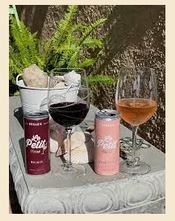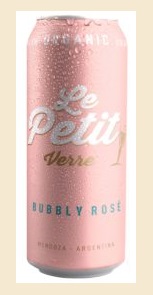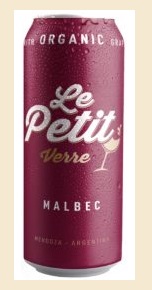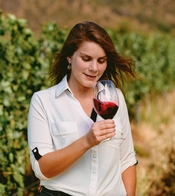|
|
 |
|
June 22, 2022
Until recently, canned wine was a category not really meant to be taken seriously by true wine lovers. The rash of “girlie names” may have been symptomatic of the alleged frivolity of the wines: Dear Mom Wine, She Can, Kung Fu Girl, Babe. While names like these may strike some people as playful and/or cute, I doubt they’ll entice even a semi-serious wine consumer into popping the tab on a can of wine. I urge you however, not to give up on this category, for canned wine appears to be advancing into a new sphere of seriousness as more producers acquire their own vineyards and make more important wines.
 I thought about all this recently when I tasted two excellent new canned wines—a sparkling rosé and a Malbec, produced by Le Petit Verre, an estate in Mendoza, Argentina. French for “The Small Glass,” Le Petit Verre’s rallying cry is “Small Can. Big Flavor.” I thought about all this recently when I tasted two excellent new canned wines—a sparkling rosé and a Malbec, produced by Le Petit Verre, an estate in Mendoza, Argentina. French for “The Small Glass,” Le Petit Verre’s rallying cry is “Small Can. Big Flavor.”
Until now, sparkling wines seem to have dominated the canned category, with steadily improved selections recently being turned out. Le Petit Verre’s Bubbly Rosé is a good example of a balanced and dry sparkler, rather than monochromatic and sweet fizz. If Le Petit Verre’s Malbec is any indication of what today’s improved canned wine can achieve, I say bring on more reds!
In addition to increasingly appealing flavors, there are other reasons to like canned wine, including practicality and environmental concerns. Cans are more sustainable than glass, they cost less than glass to produce and to recycle, and they are easier to store. Furthermore, since a canned wine weighs less than a bottle, it is more affordably transportable. Cans are less apt to break than glass, and are more appropriate for informal activities such as hiking and picnicking. Here’s a specific example:
 Domaine Bousquet, Le Petit Verre, Bubbly Rosé 2021 Domaine Bousquet, Le Petit Verre, Bubbly Rosé 2021
Mendoza, Argentina, Imported by Origins Organic
Fruit from the Uco and Tupungato Valleys
12% alcohol
$13 for a four-pack box, or $3.50 per individual per 250-ml can
The vintage is not labelled on the cans, but the wine is produced from the 2021 harvest
This wine is a good example of evolution of the best canned wines. Had I not opened the can and poured the bubbly into a glass myself, I don’t think I would have guessed it had arrived in a can. It is aromatic, fresh, and flavorful, dry rather than overtly sweet, and offers just the right intensity of small bubbles. It is made from a blend of certified organic fruit including 50% Pinot Noir, 30% Syrah, 10% Pinot Gris, and 10% Viognier. All the grapes were hand harvested. Like many wines from the Tupungato region, the fruit flavors seem especially fresh, apparently due to significant day/night temperature fluctuations and perhaps also because of the particular brightness of the sun over the Andes.
 Domaine Bousquet, Le Petit Verre, Malbec 2021 Domaine Bousquet, Le Petit Verre, Malbec 2021
Mendoza, Argentina
Imported by Origins Organic
$13 for a four-pack box or $3.50 per individual 250-ml can
The vintage is not labelled on the cans but the wine is produced from the 2021 harvest
The grapes were grown in Mendoza’s Upper Uco Valley at an altitude of 400 feet.
As was true of the sparkling wine, nothing about this Malbec’s aromas, flavors or texture would suggest that it had come in a can. Accented by fresh berry aromas and flavors, the Malbec was further enhanced by pleasing earthy notes and nicely balanced light tannins. Somewhat leaner than an average Cabernet, it will therefore a good partner for lamb, pork, burgers, or hearty grain-based dishes.
Posted by Marguerite Thomas at 1:31 PM
|
|
June 14, 2022
Summertime up here in the Northern Hemisphere – Grapes are beginning to look exuberant teenagers, and winegrowers in this top half of the globe are reviewing their summer hedging schedules. Meanwhile, way down South, the 2022 vintage is already over, and the new wines are settling in for their winter’s nap. (I must admit that even though I’ve been writing about wine for a few decades, I still have to go through the finger-calculating exercise of, “OK, if it’s February here, how close are they to harvest in the Southern Hemisphere?”)
It’s also a rite of their winter and our summer that as they put their wines to bed, those whose bottles are marketed and sold across the globe emerge like bright butterflies for their annual migration out into the field, attending wine fairs in the Northern Hemisphere, visiting their importers and distributors and talking with the media about how things turned out this season – just as winemakers from France, Spain and Italy journey to America’s East Coast in December and January to talk about their current vintages.
Which is a long way to getting around to why, on one early day in June, I find myself on a bar stool at Benoit in New York talking with Andrea Calderon, the young, talented, and gregarious chief winemaker for the 1865 brands from the San Pedro winery. Calderon is in town for a walk-around trade tasting of South American wines  nearby this afternoon, as well as for meetings with retailers and wine writers. In celebration, she sips a glass of Champagne while I have a Bloody Mary, and we begin with a discussion of the just-completed harvest. nearby this afternoon, as well as for meetings with retailers and wine writers. In celebration, she sips a glass of Champagne while I have a Bloody Mary, and we begin with a discussion of the just-completed harvest.
“We started picking Pinot Noir on February 13 in Elqui Valley and didn’t finish harvest until the beginning of May,” she says. “The Pinot Noir is looking very good with lot of fruitiness.” As Chile is a thin strip of coastal land extending roughly 2,700 miles along the Pacific in the southern portion of South America, with more than a dozen primary grape-growing valleys plunging down from the Andes Mountains to the ocean, the almost three months of harvest that Calderon experiences is not unusual, particularly since 1865 makes three lines of wines with grapes sourced from throughout the country.
“We had 10 percent less fruit than we predicted this year,” Calderon says, “because the clusters were smaller, they gave us great color. The fruit also has good persistence on the palate.” The only real downside of 2022, she says, is that there was about 30% less white wine being made than usual, especially less Chardonnay.
Going back in recent vintages, Calderon says that 2020 was a difficult vintage because of drought conditions, somewhat similar to what her California cousins have been experiencing about 6,000 miles to the north. “We had about 40% fewer grapes in 2020, but the quality was pretty good. And the Maipo and Central Valleys did pretty well with Cabernet Sauvignon and Merlot,” Calderon says. “Fortunately, by the time we got to 2021, we had learned to manage drought conditions fairly well, and it was like a more-normal year,” she says. “In 2021, the grapes had a lot of good natural acidity, and we had well-balanced tannins.”
Cabernet Sauvignon is still the wine that sells best internationally from Chile, Calderon says, and her wines have been especially well received in China and South Korea. As far as other Bordeaux grapes are concerned, in addition to Cab and Merlot, she says there isn’t as much interest in Chile in Cabernet Franc as there is in the Northern climes “because of its green notes.” Besides, she says, Carmenère, an emerging Chilean favorite, already fits that profile.
Calderon considers herself fortunate in being able to make wine from so many grapes growing in so many valleys from Elqui in the north to Malleco in the south – although she doesn’t have any vineyards yet in Patagonia. This sourcing versatility, she says, will be reflected in her afternoon walk-around, where she is pouring a Sauvignon Blanc from Leyda, a Cabernet Sauvignon from Maipo, a Carmenère from Maule and an old vines Cabernet from Curico. As her winery, San Pedro, is owned by the VSPT Wine Group, Calderon also gets to make an 1865 brand Malbec from across the mountains in Uco Valley in Argentina.
She says she is especially excited about the once-neglected old vines Cabs. “It’s like we are rescuing them,” she laughs. “There are 11 acres of them in the Lontue Valley region of Curico, and they are a new label for us” she says. “These old plants have learned to balance themselves [without prior irrigation],” Calderon adds. “We use a cold soak, but we give them less barrel times and less new oak – only about 8% – and we’re using some foudres [larger casks] with them.” She is also excited about a limited-edition Syrah from Elqui in the north.
But now it is time for Calderon to go pour wine and for me to have lunch at a nearby table with a Bourgogne producer – not his season, really – having set my palate for drinking elegant Pinot Noirs and whetting my appetite for some Bourgogne food with that bracing Bloody.
Posted by Roger Morris at 10:04 AM
|
|
 |
|